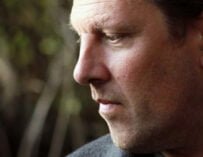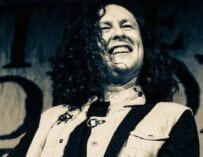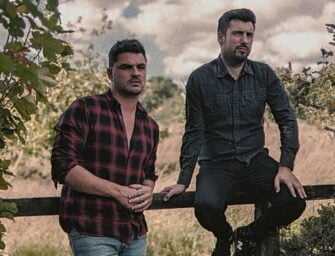This iconic 90s pop smash went through several different versions before finding a perfect home with Australian singer Natalie Imbruglia
No list of the best songs of the 1990s would be complete without Torn, the bittersweet pop smash from 1997 that helped former Neighbours actor Natalie Imbruglia leave Ramsey Street firmly behind her. So enduring is the Australian singer’s take on the track, it was the only song from the 1990s to feature in Forbes’ list of the UK’s 40 most-played songs of 2010s. That version may be unmistakeable to this day, but Torn had already been through several different lives before breaking out as the hit that made Imbruglia a worldwide superstar.
Co-written by Scott Cutler, Anne Preven and Phil Thornalley (who also produced the Imbruglia version), it’s Thornalley who will be taking us through the song’s journey. A quick namedrop of some of the artists he’s worked with down the years as either producer, co-writer or musician, is a clear indication of his calibre. Bryan Adams, Thompson Twins, The Cure, Psychedelic Furs, XTC, Duran Duran, and Paul McCartney have all made the most of Thornalley’s bona fides. Still making exceptional music, he’s just released new solo album Now That I Have Your Attention. A fabulous set of of intelligent power-pop gems directly inspired by ELO, he’s clearly still at the top of his game.
For now, we’re heading back in time to learn all about the creation of an iconic song…

Released: 27 October 1997
Artist: Natalie Imbruglia
Label: RCA/BMG
Songwriters: Scott Cutler, Anne Preven, Phil Thornalley
Producer: Phil Thornalley
UK chart position: 2
US chart position: 42
“My golden days of being the rock and roll Zelig, an in-demand mixer and producer in the 80s, had faded. I had gone from producing The Cure, mixing XTC and Duran Duran, and getting Grammy nominations for big-selling Thompson Twins albums to producing cheap demos for Keith Cullen’s bands at indie label Setanta Records.
“Anyhow, subsequently Scott and Anne wisely decided it made more sense to frame their music with a grunge rock sound, the sound of the early ‘90s, so they formed the band Ednaswap who recorded Torn twice with a very different sonic setting to our demo. Quite dark and threatening. Incidentally, the hit version of Natalie’s is closer to Anne’s original demo.
“The song composition came together over two days. It was one of three we wrote for the week’s session, also buffing up two songs that Anne and Scott already had in hand. The first day of Torn, Scott and I were messing about with drum loops. It’s incredible to imagine that loop technology is available instantly with a plug-in now, but at the time this was cutting edge, state-of-the-art production, that involved stretching and correcting the audio file. The loop we chose never quite circled perfectly, it always sounded a bit lumpy to my ears, like it had two left feet.
“Scott played chord progressions on a warm keyboard sound and I followed on my Precision bass with a Motown Can’t Hurry Love feel, knocking a track into shape with Anne sitting at the back of the room dreaming up a melody. They are both intensely focused writers and I learned a lot from them.
“In the evening, when the changes were set, Anne recorded a guide vocal with her sketched lyrics and melody. No one was jumping up and down (I write alone mostly, but still get excited when the melody and lyrics magically, through sheer hard work or even the luck of The Muse, suddenly appear to shine a path to where the song absolutely needs to go). The next morning, Anne was excited. Overnight she had re-written the lyrics and melody in her hotel room. ‘It’s called Torn,’ she stated as a fait accompli. I remember screwing my face and objecting. ‘Torn!?’ I didn’t like the title…what a genius!
“We recorded Anne’s newly created magic, a great singer btw. Usually Scott and me, in this process, would make suggestions about melodic changes on the hoof. I feel Scott would have scientifically manipulated the entry to the chorus so it resolves on the major note of the scale – teasing the notes in the bars before to draw out the tension. The ear wants the melody to land on the pleasing A of F major, but is held back by singing the B flat till the last beat. I don’t think one word of Anne’s lyrics was changed. Even then, I don’t think we were high-fiving each other in the control room. No champagne. It was very workman-like. Another day; another song.

Phil Thornalley: “The melody and lyrics are always doing the heavy lifting for any song.” Photo: Neil Mackenzie-Matthews
“I feel the juxtaposition of the lyrical angst with a cooler, pop sound created that magic bittersweet chemistry that’s been successful on records since Frank Sinatra, Motown and many more since. The push and pull of the music speaking at odds emotionally to the words.
“Over the days of the sessions, we added guitars and Anne’s ethereal background vocals. I used to record any effects like delay and reverb straight to tape (I had a crappy two-inch tape machine that was always failing), so those background vocals would sit perfectly, creating a bright sonic halo around the chorus. I played single-note bass piano notes for more drama and bottom end on the chorus. Those overdubs gave more sense of arrival in the song, that feeling of, ‘Here we are! It’s a wonderful world up here on this plateau in beautiful chorusland,’ but the melody and lyrics are always doing the heavy lifting for any song. Productions come and go but great songs…well…
“Anyway, Rusty Anderson flew over to record additional guitar parts on all our tunes. I wasn’t that confident as a guitar player then, I’d play the simple parts, but we knew he’d deliver the unexpected with his gifted, lyrical style of playing. After a week or two we had five songs ready. I was probably still trying to get the frickin’ lumpy loop to sit until we mixed the song in some downtime at a local fancy studio, Master Rock in Kilburn.
“Torn was recorded by other artists before Natalie’s version exploded. Danish A&R, Poul Bruun, LOVED the song from the get-go. He had the Norwegian balladeer Trine Rein record it – a Scandinavian No 1. Another of Poul’s artist’s, Lis Sørensen, recorded the very first cover with a Danish lyric but retitled Brændt (Burnt).
“Fast forward almost five years, my manager, Bill Stonebridge, who knew Natalie, put us together for a meeting with my new music publisher, Marc Fox. Marc heavily suggested we record Torn. He said these words, ‘I think this song will change your careers,’ how about that? At the time I was still scraping a living playing bass for my friend Edwyn Collins’ touring band, his song A Girl Like You was bringing him phenomenal, unexpected success. Some of my songs were beginning to be recorded by other artists but unfortunately no hits as yet. No life changers. I’d also just missed out on having a song on the Spice Girls album.
“Nat and I hit it off and we were both hungry for success. Both ‘cold’ in a business sense; I was nearly out of the music business and she wasn’t nearly in it. Both seemingly out of luck but reaching for the stars. We worked hard, recording and re-recording her vocal for days, trying to find the best expression from her voice. If she sings out too much, pushes too hard, then her beautiful breathy tone is lost. We would try out phrases with added blue notes to try to capture the lyrical mood. So not a one-take wonder, a studied and contrived performance. I guess her skills as an actor helped with the patience needed to put up with my demands.
“I was adding guitar parts one day then wiping them the next, looking for the perfect musical tonal combination. The last day before Nigel Godrich mixed it (he was my assistant engineer once upon a time) I decided the production sounded too perfect and re-recorded the strumming acoustic guitars and the bass guitar again, each in one take to get a more band-like feel – something looser; more artist and less machine. On my new solo album, Now That I Have Your Attention, I still use the same approach. I only stop the production when something sounds really wrong, like really awful! I don’t look for mistakes; I go with the feel.

Phil Thornalley: “The zeitgeist was in leafy West Hampstead for a heartbeat or two.” Photo: Neil Mackenzie-Matthews
“Torn had been recorded quite a few times in differing, interesting and successful ways without quite nailing the bittersweet quality of the melody and lyrics the way Nat’s heartbreaker voice did. Also, through this process, the arrangement was tightened, the instrumental bridge becoming a shorter, moodier section pedaling on a D minor. As a songwriter, I think it helps to leave the production behind for a second every now and then and sing your song at the piano, asking yourself, ‘What could your song do without?’ Too many sections? Not enough hooks? Can I breathe and sing this melody soulfully or is too busy? Is it the right key? Be your own Lennon listening to McCartney.
“Nat and I also wrote most of the songs on the seven-million-selling album Left Of The Middle together and over time the plaudits flew in. One year earlier, only Paul Curran at BMG Publishing offered me a deal (with Torn in my catalogue of tunes) – all the other major publishers weren’t interested. They had passed on a multi-million selling song. So if that’s not a lesson for songwriters to keep faith and dream their dreams, I don’t know what is.
“When the record was released, Richard Park, controller at Capital Radio, the big London station, championed and playlisted it immediately. Capital were way ahead of the BBC producers who were, as usual, trying to be cool and distance themselves from, ’Soap star does pop,’ records. They soon caught up, as did the rest of the airwaves across the world. Eventually every pop station was playing the song across the UK. I turned on the car radio taking my kids to school and flicked between Capital and Radio 1 and both stations were playing Torn. What an amazing feeling to have experienced.
“Personally, I went from zero to hero. Every label across the world was calling me to co-write and produce their artists. Torn was a worldwide phenomenon and I found myself being offered my own label, wined and dined in Hollywood; all magnificent, grade-A bullshit, but I enjoyed it for what it was on my second ride around the highs and lows of the music business. One of the artists to call was Bryan Adams, we immediately hit it off and are still co-writing tunes for his albums today.
“On Natalie’s record, while I played most of the instruments, as I generally do on all my productions, my pal David Munday played the tricky guitar parts – the electric guitar fills and the soaring anthemic slide. Incidentally on the original demo those parts had been played by Rusty Anderson, soon to become McCartney’s right hand man
“The hipster band Zero 7 had a studio a walk away from mine and we did some quid-pro-quo recording. They created the beat for Torn and I played bass and guitar on their soon-to-be massive album Simple Things. The zeitgeist was in leafy West Hampstead for a heartbeat or two.
“Katrina Leskanich of Walking On Sunshine fame, another neighbour, sang the breathy, ethereal ‘oohs’ and ‘aahs’. So all in all, with Nigel Godrich, Zero 7, Marc Fox, plus Chuck Sabo’s percussion and Katrina’s singing, there was a wealth of musical talent.
“Thankfully Anne, Scott and I remain good friends. Some of the Ednaswap fans seem to be upset that I made the song successful with Natalie, but it has been an incredible door-opener for our careers. I’m still writing and producing as a solo artist. On my new album Now That I Have Your Attention, an ironic title btw, I explore the sonic styles of the great musical Brummie: ELO’s Jeff Lynne. It’s me singing and playing all the instruments but then sweetened by real living, breathing string players for that sweeping grand orchestral effect. Revisiting a refreshing musical juxtaposition IMHO.
“When I’m asked the question, ‘What do you do?’ and I reply, ‘Songwriter’, the inevitable ‘What songs of yours would I know?’ follows. My reply is sometimes, but rarely, followed by ‘Torn? Never heard of it!’”








![Songwriting Credits… best new music playlist [September 2023]](https://www.songwritingmagazine.co.uk/wp-content/uploads/songwriting-credits-september-2023-335x256.jpg)






























Related Articles